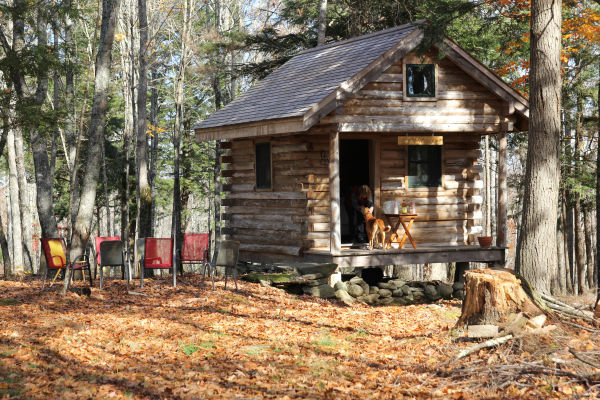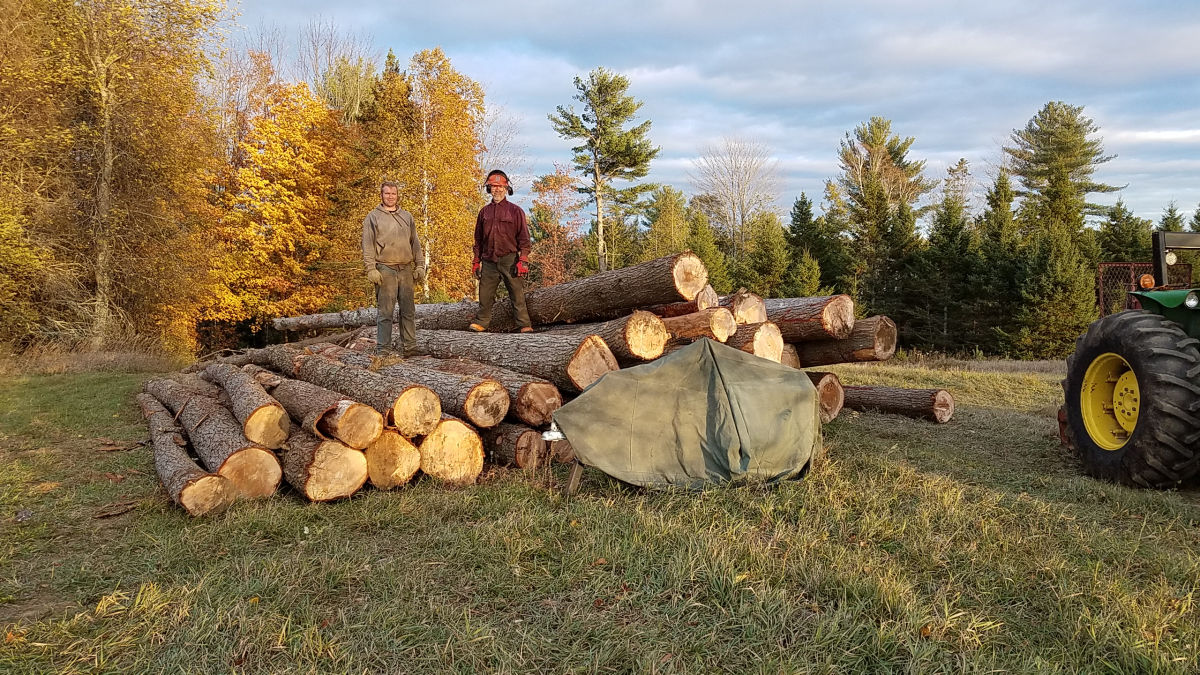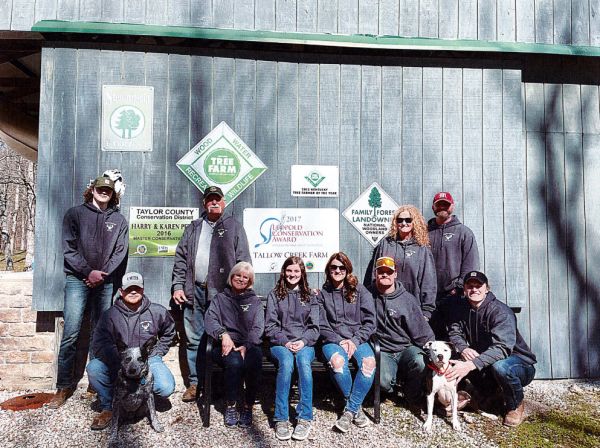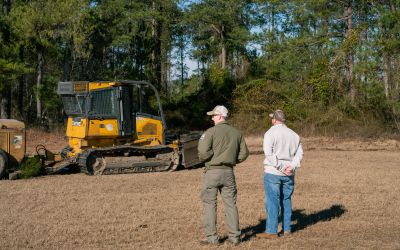A Walk in the Woods
A Special Message from Angela Wells, Director of the American Tree Farm System
In this issue of Woodland, we are launching a brand-new set of feature stories that will share more about family forest owners across the United States who are empowered to pursue conservation activities that matter to them. Going forward, each issue of Woodland will include 4 profiles of Certified Family Forests and Tree Farms. These stories will display the diversity of objectives, practices, and ecosystems represented within our community that are united by a common thread—the intent to care for land now and into the future.

In this issue, you get to learn more about the landowners selected as Regional and National Outstanding Tree Farmers of the Year for 2021. For future issues, we hope to highlight a cross-section of landowners from our community, as we know that there are many wonderful stories of stewardship that don’t often see the limelight. What makes a good forest owner feature? We want to hear stories with a strong human element, stories about lifelong learners constantly seeking new resources to help them care for their land, stories about people who are undaunted by aspirations that exceed their capabilities because they know stewardship is a lifelong (and often multi-generational) endeavor.
Please reach out to us at info@forestfoundation.org if you know a family forest owner that should be profiled, or to give us feedback on this new section of Woodland.
Don Newell
When Don and Patricia Newell acquired their 250-acre property in Thorndike, Maine, in 1978, they were motivated by a determination to keep the land from falling into uses that were unworthy of it. A man from outside Maine had purchased the property, which totaled closer to 300 acres at the time, and was attempting to divide it into residential lots while leaving small, unsustainable lots for forestry. Don, a native of the area and a real estate agent, recognized the housing lots would not sell and—more importantly—the land represented high-quality farmland and forestland that was much better suited to remain undeveloped.

Don Newell says he strives to follow the preamble to the realtor code of ethics by always pursuing "the highest and best use of the land."
Newell stepped in to buy the property when the developer’s financial circumstances wobbled, selling the land with the prime soil for farmland and keeping the remaining forestland for his family. In the years since, he’s been guided in the management of the property by the same impetus that inspired him to purchase the land in the first place —the preamble to the realtor code of ethics, which begins, “Under all is the land. Upon its wise utilization and widely allocated ownership depend on the survival and growth of free institutions and of our civilization. Realtors should recognize that the interests of the nation and its citizens require the highest and best use of the land.”
“It’s something I take very seriously,” Newell said. “I try to live by it every day.”
As part of that, Newell has perpetually sought to seek out resources and experts to help him be as good a steward of his woodland as possible. Newell points to a birth defect that left him with a “flat” foot as part of the inspiration for his head-long pursuit of forestry success. From a young age, the physical challenges associated with the foot taught him to always be considering his strengths and how to “lean on them.” He grew up to run a marathon and to spend hours first thing in the morning and on weekends traversing across his property, forever looking for ways to help it thrive.
Newell said working on his land has become an important mental exercise for him that replenishes him and refreshes him for the challenges of his day job. He loves to get up early, go work on his woodlot for a few hours, shower, and then dive into the intricacies of working with buyers and sellers of residential properties.
“I’m addicted to it,” Newell said.

Don Newell takes great pride in the hands-on work he does managing his property in Thorndike, Maine. He believes it is important for him to continuously be learning about best woodland management practices.
In recent years, Newell thinned 20 acres for high-quality stems and released crop trees on 50 acres for robust crown development. With the help of forester Rob Nelson, Newell planted 2,500 spruce seedlings in a 10-acre clearcut in 2018 and 150 spruce in a two-acre clearcut in 2019. Each spring, he transplants 300 spruce seedlings from his woodlot to a small rocky field behind his house for Christmas trees, a wildlife thicket, and pole-sized timber. Even after 40-plus years of ownership, Newell said he’s still learning and searching.
“There’s plenty for me to do to improve my woodlot,” Newell said. “And I’m going to keep at it.”
Through it all, Newell has aimed to make his property a place where the public can come for recreation—from hiking to cross-country skiing—to find the energy and peace in it that he finds there. In this way, he said, they become owners of the land, too. He recalls encountering a woman on a hike who thanked him for the opportunity to enjoy the property. She’d been thinking about what the most appropriate word to describe the place was.
She told him she’d decided the best word was “magical.”
Newell had grinned at her and nodded. “That’s a good word for it.”
Foots Parnell
Leighton “Foots” Parnell had been missing a lot of church, and his minister had noticed. After one Sunday service, his minister asked Parnell about it. Parnell explained that he had been watching the livestream of the services at Foothills Farm, the 648-acre Alabama Tree Farm where he now spent most weekends. The property, located about 75 minutes from his Birmingham home, has been in his family for generations, and he loved it there.
His minister understood. “You’re out there renewing your soul,” he said.
Parnell smiled. “That’s exactly what I’m doing.”
Parnell’s property has been in the family in some form or fashion since “before Alabama was a state,” he said. The land is marked by a diverse array of hills, valleys and flat areas. Parnell and his wife, Allene, built a cabin on the property in 2006, and they also installed a gazebo on a hilltop that offers stunning 15-mile views and a perfect place to end the day at dusk, often in the company of deer and other creatures. A feeder below the cabin in an open field attracts a variety of wildlife. Parnell calls it his “field of dreams.”
“This property is extraordinarily special to me and my family,” Parnell said.

Allene and Leighton “Foots” Parnell at the driveway entrance to Foothills Farm, their 648-acre Alabama Tree Farm. The couple built a cabin on the property and love spending time there.
Parnell learned a love for the outdoors when he was a child, largely due to the influence of a grandfather who was an avid outdoorsman. After his father died and Parnell took over management of the property, he sat down with Allene and they studied topographical maps of the land. His father, a physician, had not been active on the farm, so “we were starting from scratch,” he said.
“All the roads had been washed away or were covered with foliage, and there were no green fields,” Parnell said. “Today we have 20 green fields, lots of trails, and a great road system that goes all throughout the property. It’s been fun to see our progress, and it’s been very rewarding. We’re doing what’s right for the property, and I get a lot of gratification from that. Everything about it excites me.”
Parnell said a strong approach to conservation is at the core of everything he does with the farm. He has worked with the Alabama Forestry Commission to develop conservation plans – he is on his second 10-year plan – and he said “we have followed them to a tee.” He has enrolled in a range of USDA programs that have “helped immensely,” he said.
Because of “sandy, loamy, gravelly soil,” Parnell said Foothills Farm is particularly conducive to longleaf pines. A recent major project was planting 40 new acres of longleaf pines, approximately 622 trees per acre. The Parnells also had a pre-scribed burn of 250 acres to control underbrush and restore nutrients in the soil.
Looking ahead, Parnell said his next major challenge is managing the approximately 150 to 200 acres of loblolly pines that his father planted about 25 years ago.
“We’ve selected the harvesting of those trees so they’re spread out beautifully on the property, but they’re beginning to die and I’m going to have to replace them,” Parnell said. “We’re working on a plan to determine the best way to systematically harvest some of the loblollies and replant with longleafs so that we will have some growth on the longleafs as the loblollies die.”
Both small and large challenges excite Parnell, and he revels in every new step he takes to strengthen his farm.
“Even if I don’t see any immediate benefit from it, I still get gratification from knowing that I’m doing the right thing,” Parnell said. “I’m not in tree farming to make money. I’m in tree farming to do what is right for this land.”
Taylor Family Elk Cave Farm
Scott Taylor remembers visiting a poplar tree stand with his father, Clifton, in 1972, on their Tree Farm, Elk Cave Farm, in Gravel Switch, Kentucky. It was a productive site, but the trees were overstocked and experts advised the family to remove some of the understory to help the crop trees. That’s just what they did. Scott was 14 at the time, but he still vividly remembers that day when the decision was made.
In February of this year, Scott stood in that same track of timber, evaluating the mature poplar there and considering the next management activity for the space. The connections to that day with his father 50 years ago resonated with him, as did the powerful opportunity to continue the legacy that long-ago experience represented: managing the land to do what was best for it.
Clifton and his late wife, Barbara, started Elk Cave Farm with the acquisition of 287 acres in 1959, the start of what would eventually grow to become 1,076 acres of certified hardwood forestland, but the family’s connection to the land goes back much further. The property today encompasses several parcels owned and farmed by previous generations of family members. Clifton, who is in his early 90s, has passed on management of the land to his sons, Scott and Steve.
A multigenerational commitment helps sharpen a focus on long-term thinking, Steve said. Clifton and Barbara taught Steve and Scott to emphasize what was best for the land, even if the greatest benefits were not apparent until you were no longer around to enjoy them.
“This is our home,” Scott said. “It’s not just a place where we’re cutting timber to make money this week. That’s something that Mom and Daddy instilled in us – this is where we’re from, and this land is our connection to our history. So we look at it that way. There’s that strong emotional hook, and that guides us in the management decisions that Steve and I make just like they drove the decisions that Mom and Dad made 40, 50, 60 years ago.”
“This is our home,” Scott said. “It’s not just a place where we’re cutting timber to make money this week. That’s something that Mom and Daddy instilled in us – this is where we’re from, and this land is our connection to our history. So we look at it that way. There’s that strong emotional hook, and that guides us in the management decisions that Steve and I make just like they drove the decisions that Mom and Dad made 40, 50, 60 years ago.”

Harry and Karen Pelle with family
Clifton and Barbara were both extension faculty members in the Kentucky and Florida university systems and accustomed to turn to academic and nonacademic experts for the insight and knowledge to strengthen their land management practices. One of Clifton’s driving interests was regenerating white oak on the land to foster long-term forest health.
The Taylors have worked with Christopher Will, a consulting forester, on the effort. Will said Clifton was a focused, determined force.
“He was willing to do whatever it took to set the stage so that when the time came to harvest some of these beautiful oak hickory forests that he would increase the probability that he could replace them with another stand of oak hickory,” Will said. “And he did that. Clifton never gave up. Even when there were challenges and setbacks, he was always determined to figure things out. He always went forward.”
As an example of the farsightedness that marked his parents’ management of Elk Cave Farm, Steve points to his parents’ decision in 1972 to join the American Tree Farm System and then more recently secure Forest Stewardship Council certification, becoming one of the first private landowners in Kentucky to earn that achievement.
A half-century later, the Taylors are seeing more and more buyers who value that distinction and are seeking FSC-certified or PEFC-certified wood. For instance, it was key to Elk Cave Farm becoming the first white oak log supplier to Irish Distillers Ltd. for the production of PEFC-certified whiskey barrels in the United States.
“They wanted wood for their barrels that was sourced from sustainably managed forests,” Steve said. “Our parents were visionary in that sense. They jumped on this long before everyone realized it would be important, and we’re benefiting from it today.”
Related Articles

April 23, 2024
Turning Farm to Forest: Growing Loblolly Pine with Field to Forest
Wade Rabun has been working his land for years: he has most recently become the steward of a growing loblolly pine forest after enrolling in Field to Forest.

April 2, 2024
Georgia Landowner Grows Pines for Profit with Field to Forest
The Family Forest Carbon Program’s Field to Forest project is available to Georgia landowners who own 40+ acres of pasture or row crops.

February 20, 2024
For Conservation, Climate and Grapes
In Allegany County, you can spot newly planted grapevines. To the Trezise family, Kevin, Rene, and their son Bryce, this is the site of their future farm and vineyard.